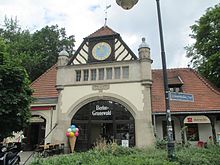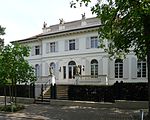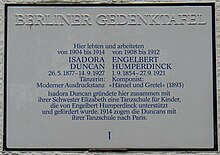Berlin-Grunewald
|
Grunewald district of Berlin |
|
|---|---|
| Coordinates | 52 ° 29 ′ 0 ″ N , 13 ° 16 ′ 0 ″ E |
| surface | 22.33 km² |
| Residents | 10,999 (Dec. 31, 2019) |
| Population density | 493 inhabitants / km² |
| Post Code | 14193 |
| District number | 0404 |
| Administrative district | Charlottenburg-Wilmersdorf |
Grunewald is a district in the west of Berlin's Charlottenburg-Wilmersdorf district and was named after the Grunewald forest of the same name . The district is one of the wealthiest areas in Berlin.
history
In the 1880s, following personal intervention by Chancellor Otto von Bismarck , the Prussian state sold 234 hectares of the Grunewald forest to the Kurfürstendamm-Gesellschaft , a bank consortium that had set itself the goal of creating an even more expensive one based on the model of the extremely successful villa colonies Alsen and Lichterfelde to build a residential area. The later "Millionaire Colony Grunewald" was created. In this context, the Kurfürstendamm was also expanded, and so a new noble residential area, the villa colony Grunewald, was built at its western end in 1889.
Due to structural requirements, large plots of land were required, only a small part of which could be built on. Grunewald developed into one of the wealthiest residential areas in Berlin, although the villas are stylistically very heterogeneous. Around 1870 the artificial lakes Hubertussee (previously: Torffenn ), Herthasee (Rundes Fenn) , Koenigssee (Langes Fenn) and Dianasee (Diebsloch) , located in the glacial channel of the Grunewaldseenkette , were excavated and filled with water via artesian wells . They were created along the formerly swampy area. This achieved two things at the same time: on the one hand, it eliminated moorland areas ( fenns ), which were feared as sources of infection , and on the other hand, it created attractions for the potential residents at the same time, as the villas were grouped around the lakes and the lakeshore and hillside areas were free of anyone Buildings remained and became private gardens and parks. Large numbers of entrepreneurs, bankers, academics and artists, often of the Jewish religion, chose the now attractive area as their residential area.
The clearing necessary for the construction work and the resulting wood sales were reflected in the Berlin street hooter Im Grunewald, in Grunewald is wood auction , which was founded around 1892.

When it was incorporated into Greater Berlin in 1920, 6449 inhabitants were counted in Berlin-Grunewald rural community and 507 inhabitants in Berlin-Grunewald forest district . From Grunewald station in place during the Shoah in October 1941, the deportation of Berlin Jews primarily in easternmost concentration and extermination camps . The memorial platform 17 has been a reminder of this since 1998 .
Gaps torn by Allied air raids in World War II were partly filled with new villas or larger single-family houses, but partly also with profane rental architecture.
In the post-war years , the Teufelsberg , named after the nearby Teufelssee, was heaped up in Grunewald from rubble and rubble from the destroyed inner-city district on the site of the unfinished and abandoned Defense Technology Faculty of the National Socialists . The Teufelsberg is today the second highest elevation in Berlin. During the Cold War , the US Forces set up an air traffic control and listening station on the top of the mountain. After the fall of the Berlin Wall and the withdrawal of the Allies, the striking ruin complex fell into disrepair. The building is currently empty. In the meantime, guided tours are offered that also explicitly refer to the street art that was created in and on the buildings in the post-reunification years .
The people of Grunewald live linguistically correct in (not in ) Grunewald. The district is still the most expensive property area in the Berlin villa arc, which extends in the south-west of the city from Lichterfelde-West in the south, via Dahlem and Grunewald to Westend . As in many cities, the prevailing westerly wind conditions also played a role here, as the exhaust gases from business and domestic heating systems are blown in the opposite direction.
traffic
The Grunewald train station serves the S-Bahn line S7. This line connects to the historical center and the city of West Berlin with Potsdam .
At the east end of the district begins at Rathenauplatz the Kurfürstendamm , which leads from here through the entire City West and on Breitscheidplatz with the Kaiser Wilhelm Memorial Church in Charlottenburg ends. Also starting from Rathenauplatz is a motorway junction of the Berlin city ring A 100 .
The AVUS , which runs from the city ring at Dreieck radio tower to Spanische Allee in Nikolasee and on as A 115 to Berliner Ring ( A 10 ), runs parallel to the S-Bahn tracks to the west. The AVUS is the main connection for individual traffic between downtown Berlin and the villa suburbs on the Großer Wannsee and Potsdam . It was the world's first autobahn in 1921 . It divides the district of Grunewald into two halves, with the villa colony Grunewald on the eastern side and the almost uninhabited Grunwald forest on the western side . On the occasion of the 1936 Summer Olympics , both the marathon course and the road bike race course were run by AVUS.
Buildings and monuments
- Grunewald Tower
- Grunewald station with the memorial platform 17
- Bismarck Monument at Bismarkplatz
- Villa Harteneck and Villa Konschewski
- Villa Kemmann
- St. Michaels Home (formerly: Palais Mendelssohn )
- Villa Nathan Samuel / Leo Czapski
- Villa Noelle
- Lion Palace
- Shield horn monument
- Castle Hotel in Grunewald (formerly: Palais Pannwitz )
- Steffi Graf Stadium
- Teufelsberg with wiretapping of the US Army
- Villa Walther
- Home of Walther Rathenau
- Wissenschaftskolleg zu Berlin (formerly: Villa Linde )
Public facilities

Sacred buildings
- Catholic Church of St. Charles Borromeo
- Evangelical Grunewald Church
Educational institutions
- Grunewald primary school
- Hildegard Wegscheider High School (grammar school)
- Walther Rathenau School (high school)
- European Academy Berlin
- Nature conservation center Ökowerk Berlin
Diplomatic missions
Embassies
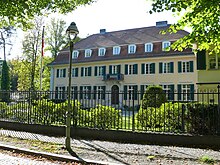
The embassies of the federal states are located in Grunewald
- Afghanistan
- Azerbaijan
- Ivory Coast
- Qatar
- Kuwait
- Laos
- North Macedonia
- Poland (temporarily)
- Serbia
- United Arab Emirates
Residences

In addition, the following countries maintain private ambassadors' residences in the Grunewald district:
- Australia
- Ireland
- Iceland
- New Zealand
- Norway
- Turkey
- Czech Republic
- United Kingdom
- People's Republic of China
Personalities
This district had and has many prominent residents from politics, science, culture and business:
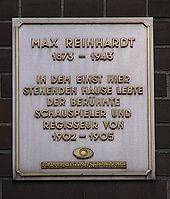
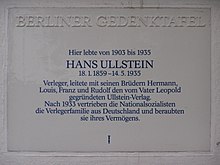
- Gustav Ahrens , 1894–1914: Schwedlerstrasse 4–6.
- Fritz Ascher , 1942–1945: Lassenstrasse 28, 1945–1970: Bismarckallee 26
- Berthold Auerbach , lived from 1859 in Auerbachstrasse , which was later named after him; 1938 changed Nazi district administration this street names because of Jewish descent Auerbach after Vogtland City Auerbach in Auerbach road.
- Ingeborg Bachmann , Hasensprung 2 and Koenigsallee 35
- Friedrich Bär , Humboldtstrasse 13
- Michael Ballhaus , Wangenheimstrasse 20
- Lulu Basler theater actress, 1st wife of Curd Jürgens , Douglasstrasse 13–15
- Vicki Baum , 1926–1932: Koenigsallee 43–45
- Walter Benjamin , 1913–1928: Delbrückstrasse 23
- Jack O. Bennett , 1974-2001: Trabener Strasse 68a
- Jeanette Biedermann , Koenigsallee
- Siegmund Bodenheimer , Richard-Strauss-Straße 29–33
- Dietrich Bonhoeffer , Wangenheimstrasse 14
- Artur "Atze" Brauner , producer, Koenigsallee 18
- Arno Breker , lived at Koenigsallee 65 in 1940
- Emil Bücherl , Wangenheimstrasse
- Sarah Connor , since 2010
- Emma Cotta , Auguste-Viktoria-Straße 4, then 1945–1957: Caspar-Theyß-Straße 14
- Isadora Duncan , Trabener Strasse 16
- Gisela Fackeldey , actress
- Lyonel Feininger , 1908–1913: Königstrasse 32
- Lion Feuchtwanger , 1930–1933: Regerstraße 8
- Joschka Fischer , politician
- Samuel Fischer , Erdener Strasse 8
- Carl Fürstenberg , Koenigsallee 53
- Gustaf Gründgens , until 1937: Hagenstrasse 31a
- Maximilian Harden , 1894–1923: Wernerstraße 16
- Gerhart Hauptmann , Trabener Straße 54 and Hubertusallee
- Johannes Heesters , 1936–1943 and after 1946: Hubertusbader Straße 16
- Heinrich Himmler , Hagenstrasse 22
- Christian Kraft zu Hohenlohe-Öhringen , Humboldtstrasse 22
- Marianne Hoppe , Caspar-Theyss-Straße 14
- Camilla Horn , 1936/37: Knausstrasse 10–12
- Engelbert Humperdinck , 1901–1912: Trabener Strasse 16
- Harald Juhnke , Richard-Strauss-Strasse 26, Lassenstrasse 1
- Curd Jürgens , Douglasstrasse 13–15 at Lulu Basler's
- Helmut Käutner , Koenigsallee 18g
- Alfred Kerr , 1910–1921: Gneiststrasse 9, 1921–1929: Höhmannstrasse 6 and 1929–1933: Douglasstrasse 10
- Julia Kerr , 1920–1921: Gneiststrasse 9, 1921–1929: Höhmannstrasse 6 and 1929–1933: Douglasstrasse 10
- Michael Kerr , 1921: Gneiststrasse 9, 1921–1929: Höhmannstrasse 6 and 1929–1933: Douglasstrasse 10
- Judith Kerr , 1923–1929: Höhmannstrasse 6 and 1929–1933: Douglasstrasse 10
- Harry Graf Kessler , 1925–1930: Höhmannstrasse 6
- Erich Kips , 1912–1915, Herthastraße 20
- Hildegard Knef , Bettinastraße 12, Brahmsstraße 12
- Felix Koenigs , banker and patron of the arts, in Koenigsallee 1, named after him
- Viktor de Kowa , Koenigsmarckstrasse 9
- Klaus-Rüdiger Landowsky , Fontanestrasse
- Else Lasker-Schüler , 1913: Humboldtstrasse 13
- Rolf Lauckner , 1931–1954: Bettinastraße 3
- Otto Lessing , 1894–1910: Wangenheimstrasse 10 and Atelier Caspar-Theyß-Strasse 12
- Harry Meyen , Winkler Strasse 22
- Franz von Mendelssohn the Younger , Bismarckallee 23, "Mendelssohn-Palais"
- Brigitte Mira , until 2005: Koenigsallee 83
- Ernst Noelle , 1901–1922: Winkler Strasse 10
- Alexander Oppler and Ernst Oppler : Hagenstrasse 8
- Max Pechstein , 1945–1955: Hubertusallee 18
- Max Planck , 1905–1944: Wangenheimstrasse 21
- Arthur Pohl , 1958–1970: Koenigsallee 30–32
- Hermann Priebe , 1905–1949: Pastor of the Grunewald Church , Bismarckallee
- Walther Rathenau , 1910–1922: Koenigsallee 65
- Max Reinhardt , 1902–1905: Fontanestrasse 8
- Ferdinand Sauerbruch , 1939–1951: Herthastraße 11
- Peter Schamoni , 1967–1998: Furtwänglerstraße 19
- Ulrich Schamoni , 1967–1998: Furtwänglerstraße 19
- Romy Schneider , Winkler Strasse 22
- Angelika Schrobsdorff , writer, grew up in a villa on Johannaplatz . She spent her old age in Schmargendorf, exactly on the border with Grunewald and a ten-minute walk from Johannaplatz.
- Olli Schulz , singer, actor, presenter
- Hermann Amandus Schwarz , Humboldtstrasse 33
- Nicolaus Sombart , Humboldtstrasse 35a
- Werner Sombart , Humboldtstrasse 35a
- Hermann Sudermann , 1910–1928: Bettinastraße 3
- Louis Ullstein , Höhmannstrasse 10
- Grethe Weiser , Herthastraße 17a
- Bernhard Wieck , 1891–1913: Herthastraße 4, Grunewald's first official and community leader
- Paul Wittig , 1899–1943: Menzelstrasse 26–28, Dachsberg 9, Knausstrasse 4–6
See also
- List of streets and squares in Berlin-Grunewald
- List of cultural monuments in Berlin-Grunewald
- List of stumbling blocks in Berlin-Grunewald
literature
- Helga glasses, Karl-Heinz Metzger u. a .: 100 years of the Grunewald villa colony 1889–1989. District Office Wilmersdorf, 1988.
- Reinhard Milferstädt: The Grunewald villa colony. Origin and development of an upper-class residential area in the 19th century. TU Braunschweig.
- Herbert Siebert: Berlin-Grunewald: A home book. Berlin 1930, OCLC 250170189 .
- Maria Berning, Michael Braum, Engelbert Lütke Daldrup , Klaus-Dieter Schulz: Berlin residential quarters: A guide through 60 settlements in East and West. Reimer Verlag, Berlin 2003, ISBN 3-496-01260-9 .
- Peter-Alexander Bösel: Berlin-Grunewald in historical views. Sutton-Verlag, Erfurt 2005, ISBN 3-89702-853-0 .
- Christian Simon: Wilmersdorf - between idyll and metropolis . be.bra verlag, Berlin 2015, ISBN 978-3-8148-0210-7 .
Web links
- Karl-Heinz Metzger: The villa colony Grunewald. BA Charlottenburg-Wilmersdorf, accessed on October 12, 2013 .
Individual evidence
- ↑ Grunewald Colony (overview map) . In: Berliner Adreßbuch , 1892, after Part 1, p. VI.
- ↑ Ludewig Wittmack : The Booth conifers in the Grunewald near Berlin. In: Garden flora . No. 42. Paul Parey, 1893, pp. 339–340 and a trip to the Grunewald colony . In: Gartenflora , Volume 48, Paul Parey, 1899, p. 417 ff.
- ^ Karl-Heinz Metzger: The villa colony Grunewald . District Office Charlottenburg-Wilmersdorf of Berlin, berlin.de, accessed on August 1, 2015.
- ↑ The Grunewald is forest area of the year 2015. ( Memento from March 4, 2016 in the Internet Archive ) Grüne Liga Landesverband Berlin e. V., accessed on August 1, 2015.
- ↑ Ingeborg Bachmann, Hans Werner Henze, Hans Höller: Letters of a friendship: with 8 facsimiles. 2nd edition. Piper, 2006, ISBN 3-492-04608-8 , p. 509.
- ↑ That has become a spoofed, spoiled story . In: Deutschlandradio Kultur . ( deutschlandradiokultur.de [accessed on March 11, 2017]).



